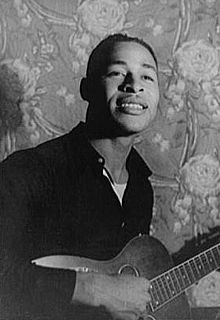Gabriel Brown
| Gabriel Brown | |
|---|---|

Brown, photographed by Carl Van Vechten in 1935
|
|
| Background information | |
| Born | 1910 Florida, United States |
| Died | 1972 Florida, United States |
| Genres | Piedmont blues |
| Occupation(s) | Singer, guitarist, songwriter |
| Instruments | Vocals, guitar |
| Years active | 1935–1952 |
| Labels | Various |
Gabriel Brown (1910–1972) was an American Piedmont blues singer and guitarist.
Brown was born in Florida, probably in Gadsden County, and graduated from the Florida Agricultural and Mechanical College. In 1934, he performed at the first National Folk Festival in St. Louis, Missouri. He was musically discovered by folklorist Zora Neale Hurston. She enlisted Alan Lomax, who recorded Brown for the Library of Congress in June 1935.
Like Ralph Willis, Alec Seward and Brownie McGhee, Brown then relocated from the South to New York City. Hurston gave Brown a part in her light opera Polk County. In 1935 Brown started a four-year tenure with the Federal Arts Theatre, initially under the direction of Orson Welles. By the late 1930s, Brown appeared as a singer on Cincinnati radio and took part in the show St. Louis Woman. He found employment with the civil service, working for the Army Signal Corps in Asbury Park, New Jersey. His first full recording session was in 1943, produced by Joe Davis, and the twosome worked together until Brown's final sessions in 1952.
...
Wikipedia
